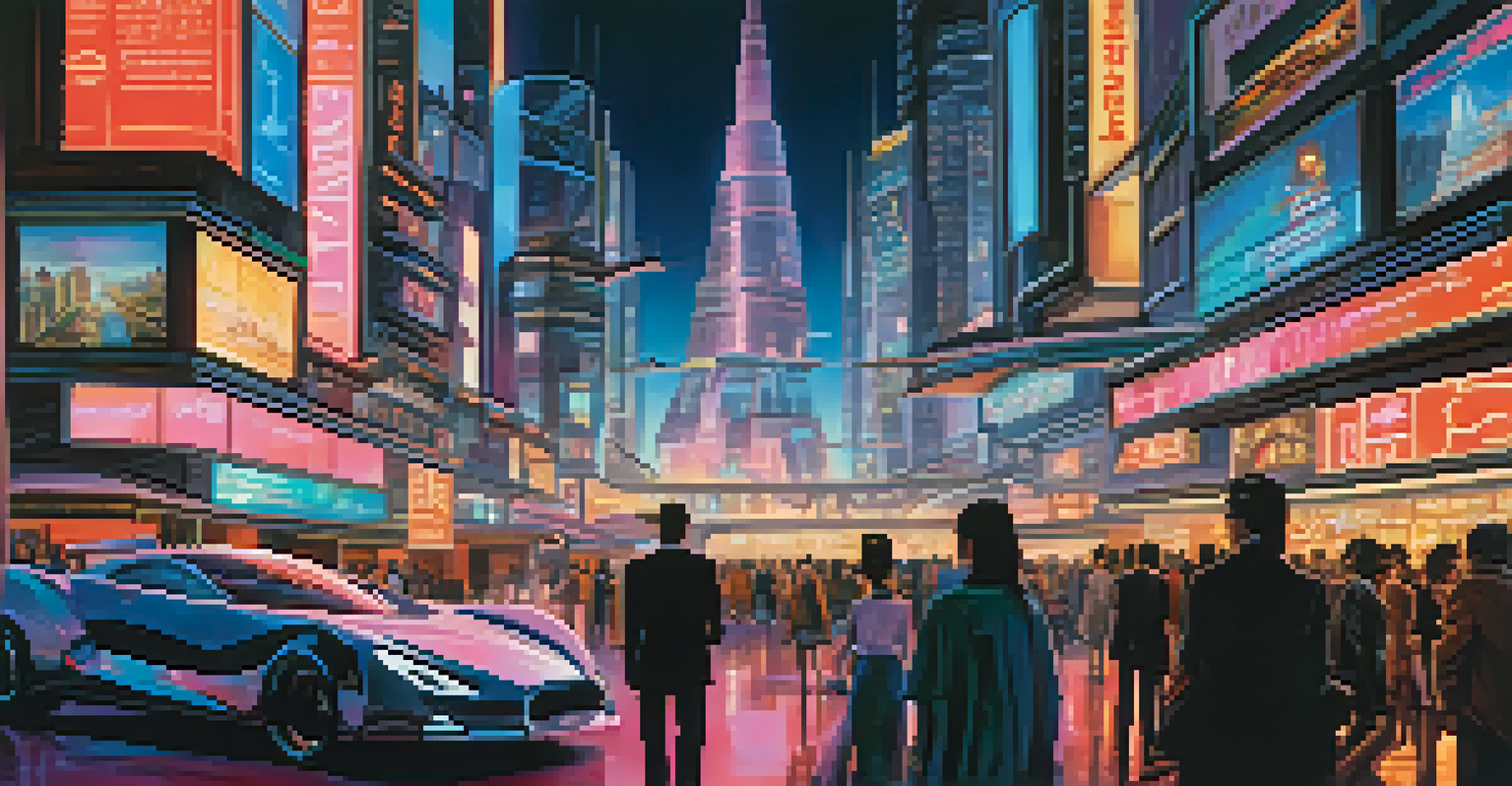The Impact of CGI on Modern Filmmaking Techniques

Understanding CGI: The Basics and Beyond
Computer Generated Imagery, or CGI, refers to the creation of still or animated visual content with computer software. This technology has revolutionized the way filmmakers visualize their ideas, allowing them to create scenes and effects that were once thought impossible. From animated characters to entire virtual worlds, CGI provides filmmakers with the tools to push creative boundaries.
Computer graphics allow you to visualize things that you cannot see in any other way.
In simpler terms, think of CGI as digital magic. Just like a magician uses tricks to create illusions, filmmakers use CGI to bring their fantastical visions to life. Whether it's the dinosaurs in 'Jurassic Park' or the intricate landscapes in 'Avatar,' CGI has become a vital part of modern storytelling.
Understanding CGI is crucial as it opens up a realm of possibilities for filmmakers. It allows not only for grand visual spectacles but also for more nuanced storytelling, where emotions can be conveyed through digital characters, thus enhancing the audience's connection to the narrative.
How CGI Enhances Visual Storytelling
One of the most significant impacts of CGI in filmmaking is its ability to enhance visual storytelling. With CGI, directors can craft stunning visuals that complement the narrative, creating an immersive experience for the audience. For instance, the breathtaking landscapes in 'The Lord of the Rings' trilogy captivate viewers and transport them into the heart of Middle-earth.

Moreover, CGI allows for the portrayal of complex emotions and actions that would be difficult to achieve with traditional effects or live-action alone. Characters like Gollum, created through a blend of CGI and motion capture, showcase how technology can breathe life into characters, making them relatable and memorable.
CGI Transforms Visual Storytelling
CGI enhances filmmaking by creating immersive visuals that deepen emotional connections and enrich narratives.
By seamlessly blending CGI with live-action, filmmakers can create a richer narrative tapestry. This technique not only enhances the aesthetic appeal but also serves to deepen the audience's engagement, making them feel like active participants in the story.
The Evolution of CGI in Filmmaking
The journey of CGI in filmmaking has been nothing short of remarkable. From its inception in the late 1970s and early 1980s, where it was used sporadically, to its widespread adoption in the 2000s, CGI has evolved significantly. Early examples like 'Star Wars' showcased primitive CGI, but they laid the groundwork for future innovations.
The best films of the future will be made by filmmakers who can blend technology with storytelling.
As technology advanced, so did the quality and complexity of CGI. With the introduction of better software and hardware, filmmakers began to create more realistic and intricate effects. This evolution has allowed movies like 'Inception' and 'The Matrix' to incorporate mind-bending visuals that challenge our perception of reality.
Today, CGI is not just an add-on; it's an integral part of the filmmaking process. Filmmakers now design their projects with CGI in mind, allowing for a more cohesive integration of visual effects that enhances the overall storytelling experience.
CGI vs. Practical Effects: A Balancing Act
The debate between CGI and practical effects has been ongoing in the film industry. While CGI offers a plethora of creative possibilities, many filmmakers still value the authenticity that practical effects bring to a scene. For instance, the use of animatronics in 'Jurassic Park' provided a tangible, physical presence that CGI alone could not achieve.
However, the best films often strike a balance between the two. By combining practical effects with CGI, filmmakers can create a more immersive experience. A perfect example is 'Mad Max: Fury Road,' which utilized real stunts and vehicles, enhanced with CGI to create a breathtaking visual narrative.
Balancing CGI and Practical Effects
The best films often blend CGI with practical effects to create authentic and captivating cinematic experiences.
Ultimately, the choice between CGI and practical effects comes down to the story being told. Each has its strengths, and when used in harmony, they can elevate a film to new heights, captivating audiences and creating unforgettable cinematic moments.
CGI's Role in Redefining Genre Boundaries
CGI has played a pivotal role in redefining genre boundaries in filmmaking. Genres like fantasy and science fiction have greatly benefited from CGI advancements, allowing filmmakers to create worlds that were once confined to the pages of books. For instance, films like 'Guardians of the Galaxy' have merged humor, action, and stunning visuals to create a unique cinematic experience.
Moreover, CGI has enabled filmmakers to experiment with genre conventions. The blend of horror and CGI in films like 'It' showcases how visual effects can heighten suspense and fear, creating a more visceral experience for the audience. This freedom to innovate has led to the emergence of hybrid genres, captivating diverse audiences.
As filmmakers continue to push the boundaries of CGI, we can expect even more innovative storytelling. The ability to create diverse worlds and characters opens up a treasure trove of possibilities, fundamentally altering how stories are told across different genres.
The Future of CGI in Filmmaking
As we look to the future, the role of CGI in filmmaking is only expected to grow. With advancements in technology such as virtual reality (VR) and augmented reality (AR), filmmakers have even more tools at their disposal to create immersive experiences. Imagine stepping into a movie world where you can interact with characters and environments; CGI is paving the way for such possibilities.
Additionally, artificial intelligence (AI) is beginning to play a role in CGI creation, enhancing efficiency and creativity. AI can assist in generating realistic animations and visual effects, allowing filmmakers to focus more on storytelling rather than technical constraints.
CGI Redefines Genre Boundaries
CGI allows filmmakers to merge genres and experiment with storytelling, leading to innovative cinematic experiences.
The future of CGI holds exciting potential, not just for filmmakers but for audiences as well. As technology continues to advance, we can anticipate a new era of storytelling that blurs the lines between reality and imagination, inviting viewers to engage with narratives like never before.
The Cultural Impact of CGI in Film
CGI has not only transformed filmmaking but also significantly influenced popular culture. Iconic CGI characters and scenes have become ingrained in our collective memory, shaping how we perceive and discuss cinema. For instance, the visual spectacle of 'Avatar' not only broke box office records but also sparked conversations about environmentalism and technology.
Moreover, CGI has democratized filmmaking, allowing independent filmmakers to create high-quality visuals without the need for massive budgets. This accessibility has led to a surge of creativity, with unique voices emerging in the industry and contributing to a richer cinematic landscape.

As CGI continues to evolve, its cultural implications will undoubtedly expand. From influencing fashion trends to inspiring video game design, the impact of CGI on film reverberates beyond the screen, shaping various facets of contemporary culture.